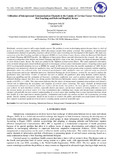Utilization of Interpersonal Communication Channels in the Uptake of Cervical Cancer Screening at Moi Teaching and Referral Hospital, Kenya
Abstract
Worldwide, cervical cancer is still a major health concern. The problem is worse in developing nations because there is a lack of access to trustworthy cancer information, which discourages people from getting screened. The usefulness of interpersonal communication channels in spreading awareness about cervical cancer screening was investigated in this inquiry. The study was carried out at the Moi Teaching and Referral Hospital (MTRH) in Uasin Gishu County, Kenya, within the Maternal Child Health and Family Planning (MCH/FP) facility. The Diffusion of Innovations Theory provided direction for the research. The study was conducted at Maternal Child Health and Family Planning (MCH/FP) clinic at the Moi Teaching and Referral Hospital (MTRH) in Uasin Gishu County, Kenya. The study was guided by the Diffusion of Innovations Theory. This study employed a descriptive cross-sectional design and a mixed methods approach to investigate cervical cancer information sources. Targeting women aged 18-65 receiving family planning services at MTRH, the sample of 308 was derived from the monthly population of 1,000. Six key informants were purposively chosen for qualitative data, and 20 participants for focus groups using systematic random sampling. Quantitative data was collected using semi-structured questionnaires while qualitative data was collected using two focused group discussions and six key informant interviews. Statistical Package for Social Sciences, version 29, was used to analyse the quantitative data, and NVivo, version 12 software was used to analyse the qualitative data using thematic content analysis. Regression modelling and the estimation of Pearson's correlation coefficient were used to perform inferential statistics. The tabulated findings suggest that there was strong positive link between information sources adopted and cervical cancer testing uptake (r=0.876, p = <.004). This observation indicates that the choice of interpersonal communication medium used played a crucial role in influencing the acceptance and adoption of cervical cancer screening. The major channels of interpersonal communication utilized were friends, health care workers and the media. Out of these, the most effective channels were health care workers. As such, healthcare workers, especially doctors and nurses, can increase women's screening adherence to lessen the societal burden of cervical cancer. It is thus recommended that combining mass media and interpersonal communication channels will probably increase women's understanding of cervical cancer thus enabling them to make informed decisions about their health. It is also important to sensitize families, communities and health care workers on their role in promoting screening uptake. Specific training programmes should be put in place to sensitize the public and health care professionals and increase their capacity to promote uptake of cervical cancer screening among women of vulnerable ages.
URI
https://doi.org/10.51867/ajernet.4.2.126https://ajernet.net/ojs/index.php/ajernet/article/view/227
http://ir-library.mmust.ac.ke:8080/xmlui/handle/123456789/2471
Collections
- Gold Collection [1026]

